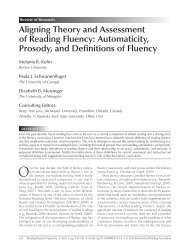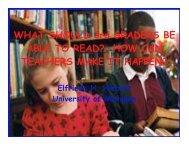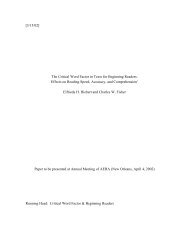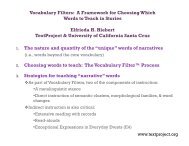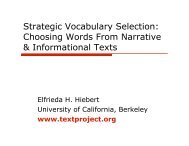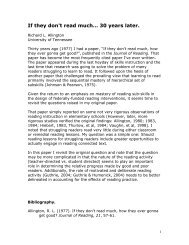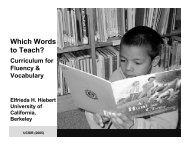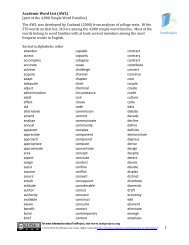Vocabulary Megaclusters - TextProject
Vocabulary Megaclusters - TextProject
Vocabulary Megaclusters - TextProject
You also want an ePaper? Increase the reach of your titles
YUMPU automatically turns print PDFs into web optimized ePapers that Google loves.
<strong>Vocabulary</strong> <strong>Megaclusters</strong>TABLE 4Distribution of <strong>Megaclusters</strong> Across Rare Words of an ELA UnitMegacluster Examples Narrative• Communication summoned, shrieked .11• Emotions & Attitudes anticipation, expected .04• Traits of Characters daring, dignified .02• Social Relationships peculiar, free .03• Characters (Occupations, People, Groups) duke, magician .06• Action & Motion dangled, swatted .15• Comparatives/Values identical; useless .04• Body & Health muscles, vaccine .03• Places/Dwellings homeland; mansion .04• Physical Attributes massive .10• Nature precipitation, sedimentary .26• Machines pulley, vehicle .07• Social Systems sculptures, payroll .05To determine how well the <strong>Vocabulary</strong> <strong>Megaclusters</strong> accounted for the newlyadded vocabulary, words that had been identified as rare in Table 2 (i.e., the149 that appeared in WordZones 5 and 6 in the ELA unit) were examined inrelation to the <strong>Vocabulary</strong> <strong>Megaclusters</strong> database. The summary of this classificationis given in Table 4. A <strong>Vocabulary</strong> Megacluster that is also common toinformational texts—Nature—had the largest corpus of words. Since two of thefive texts in the unit are magazine articles that have both narrative and informationalelements, the appearance of words having to do with nature is understandable.As would be expected of narrative text, the <strong>Vocabulary</strong> <strong>Megaclusters</strong>of Communication and Action were also heavily represented.Application of the <strong>Vocabulary</strong> <strong>Megaclusters</strong>How might the information about <strong>Vocabulary</strong> <strong>Megaclusters</strong> be used byteachers? I offer two potential routes for a “conceptual” approach to narrative:(a) shared <strong>Vocabulary</strong> <strong>Megaclusters</strong> across a set of texts and (b) unique<strong>Vocabulary</strong> <strong>Megaclusters</strong> as a function of the author’s use of language in a specifictext.Shared <strong>Vocabulary</strong> <strong>Megaclusters</strong><strong>Vocabulary</strong> that is typically critical in a narrative has to do with the ways inwhich characters communicate and with the characters’ emotions and attitudes.<strong>Vocabulary</strong> associated with these critical aspects of narratives couldbe developed with particular clusterings of texts and also could be a focus ofinstruction in different grades. Emotions of fear, joy, and anger, for example,9





